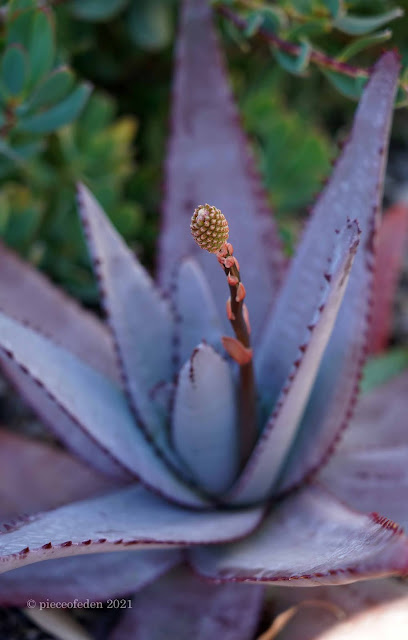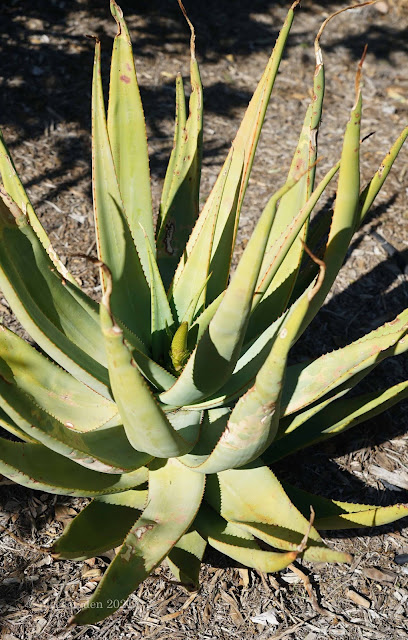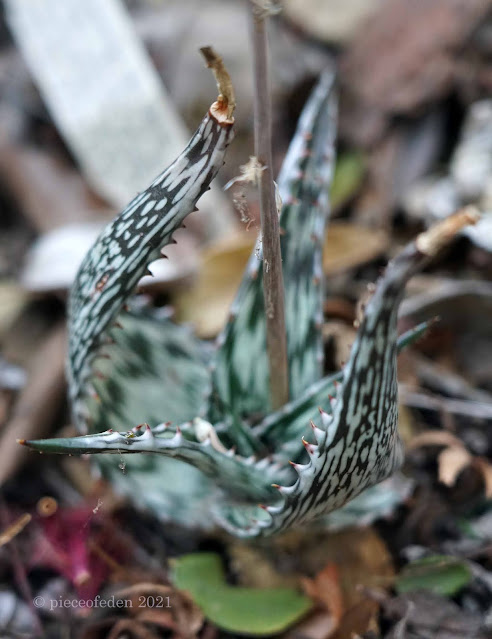First flower from this Aloe capitata var. quartziticola--who needs flowers, really, with that incredible foliage?
Many autumn-blooming Aloes are preparing to. One has begun opening: A. suprafoliata
The plant is a beauty, but its flowers go bad-hair-day as they prepare to open:
Aloe ferox appeared to have center-rotted last winter, but maybe it didn't. It seems to have recovered and regrown a fairly normal rosette, slightly tilted, along with a flower stem. The center of the plant can't be clearly seen due to its height. I'm glad it doesn't have to be removed--yet, anyway.
A closer look:
A different A. ferox, this one with white flowers, is also sending up a stem:
Yet another A. ferox. This plant was given to me as A. ferox "candelabra form" (not sure what that means) --it's also flowering for the first time in my garden:
A. ferox is nice, but...one or two is plenty.
Next, a hybrid from seeds I collected and planted from A. capitata about ten years ago. My guess: A. capitata x A. vanbalenii. It flowered for the first time last autumn, and it looks somewhat like capitata, and somewhat like vanbalenii, hence my guess.
The new A. rubroviolacea purchased some months ago and still in its nursery pot, is also preparing to flower. I had a good spot picked out for it on the front slope, but when I dug the hole, ants boiled out of it. So planting is on hold.
Aloe castenea's flower is just beginning and is barely visible:
Aloe hardyi was completely engulfed by a large-clump-forming Aloe a few years ago. When I removed the clump, hardyi was still clinging to life. I moved it to where it could drape over a wall, and it's been recovering for a while--and has decided to flower even in it's bedraggled condition:
Aloe thraskii soon to flower. At its lower right, Aloe pseudorubroviolacea won't flower until late next spring. It did pink up for the winter, though.
Aloe vanbalenii puts on a massive show. Fourteen flower stems at last count, most of them with at least three branches. There will probably be more.
Another enthusiastic bloomer is hybrid A. 'Moonglow'. Six flower stems, most with at least three branches each, at last count:What about Aloes are not about to flower? This is turning into an Aloe survey. I've done several surveys of them, and started a draft of one last year, but never finished it. So, all the rest of them...
The big 'Hercules' (A. barberae x A. dichotoma'). Aloe cryptopoda petrophila at its base, 'Fire Ranch' and A. ferox to its right. 'Hercules' has flowered several times, but the flowers are up so high and so tightly crammed between foliage, they are hard to spot.
Smallest A. aculeata at top right, and what is supposed to be A. aculeata in the wire hoop, but might be A. marlothii:
Older A. aculeatas. This solitary species is very ornamental both in and out of flower, so multiple plants are welcome.
Kumara (formerly Aloe) plicatilis at right. It sends up flower stems later, in winter.
The very elegant hybrid 'Hellskloof Bells', (A. pearsonii x A. distans). This plant has an alluring soft sheen to its leaves. The edges of the leaves will pink up with stress. Slow growing. A really beautiful plant and worth grabbing if you happen to see it for sale.
A. speciosa has been finicky, and has suffered several bouts of Aloe rust. I've seen several specimens die at the Huntington, so it may not be the easiest Aloe to grow in SoCal. Must give it extra care, as the flowers are stunningly beautiful.
Tiny A. hemmingii deserves better care. I've tried it in several spots, none of which seemed to satisfy it.
Clockwise from top: peglarae, betsileensis, dorotheae:
A. tweediaeae
A. dhufarensis:
A small, really red form of A. cameronii. It greens up a bit in late spring and early summer, but it takes on this amazing color the rest of the year.
A larger form of A. cameronii, which is quite green from early spring through summer, then turns this astonishing burgundy in late fall and winter if kept very dry:
Here's an offset of the above clump getting considerable water. Quite a different color!
A. sabea on the far lower left, 'Erik The Red' above it, A. alooides to the right,A. 'Fire Ranch' on the left, A. marlothii on the right. These look rough because the Grevillea 'Moonglow' was shading them heavily, one of the reasons I cut back the 'Moonglow' really hard some weeks back. Fallen leaves of A. 'Hercules' on the ground around them.
A second 'Fire Ranch', looking unhappy. Too dry, maybe:
Two of A. buhrii. One got quite a lot of water and has split into multiple rosettes, the other on the right is the "normal" usually solitary version. A close relative of A. striata.
A. reitzii on the left flowered in late summer. The flower stem is not yet dry enough to remove. A. 'Rooikappie' a hybrid that flowers year round, to reitzii's upper right. What is possibly another reitzii below--purchased unlabelled. Still waiting for a flower from that one.
A. 'Cynthia Giddy', a fabulous producer of flowers beloved by hummingbirds, but also a prodigious producer of offsets that grow big and heavy and spread far and wide. A once single rosette became a huge clump, which was an ordeal to remove. I ended up saving a single rosette "for the hummers". It's bloomed twice, for the hummers, but it's started prodigiously producing those offsets...
This was a gift hybrid--vryheidensis??? x marlothii???
A. tomentosa. Solitary. No offsets to plague me. Still waiting for the first flower. It's the flower that's the stunner on this species.
Clumps of Aloe noblis, which began as a single variegated rosette. Some offsets of the variegated revert to green, but then produce variegated offsets. It's quite nice for an offsetter, not too fast.
Foreground: one of the three capitata seedlings that are probably hybrids of vanbalenii, background Aloe is lukeana
The capitata mother of the capitata hybrids at top, capitata 'Yellow Hoodie' below:
Aloe brevifolia is a very tough small Aloe I wish would not offset so quickly. The rosettes as individuals remain attractive, even here in extreme hot dry soil at the edge of the street:
Aloe suzannae:
A trio of A. striata, showing variation in foliage color:
A. africana needs a spot in the ground:
So does A. rupestris:
Ditto A. castilloniae.
I think these are either ferox or marlothii. I bought them as a trio in a 2" pot at Ikea for $1.99. They were in a 144 pot tray, 143 of which were undoubtedly A. 'Vera'. They are quite attractive versions of whatever species they are, hopefully not ferox.
Hospital bed: the Buhii was getting waterlogged and needed re-rooting. The 'Congolensis' had been covered over by a Hairy Canary (Lotus hirsutus aka Dorycnium hirsutum but Lotus is easier to spell) and needed split up and re-rooted.
Is that it? Am I done? Should have split this post up.
Another hospital bed: peglarae and two broomiis. I just about killed these--they were tiny plants. They've recovered in the ground.
A. erinacea also suffered and nearly died in a pot. It had one leaf left (that one on the right) a bit of stem, and no roots, but it seems to have survived---maybe? My bad, not watering it enough.
A.krapohliana is said to be hard to grow, and it has been, but it didn't help when my mow-blow guy stepped on it. I put it in a safer place--now it's up to you, kiddo. Erinacea made it--can you?
I forgot A. striata ssp. karasbergensis and aculeata x cryptopoda, gariepensis, and 'Vera', but this has gone on long enough.






















































Aloes are amazing, and you have quite a collection. I have a few in indoor pots and they seem to be happy (knock on wood). It would be fun to grow them outside, though.
ReplyDeleteMany do great in pots. There are some very choice species (peglarae, erinacea, castilloniea, for example) just perfect for pots. (Not me, tho. I kill plants in pots.)
DeleteI knew you had a lot of Aloes but I think I still vastly underestimated the number and the variety among them. Most of the Aloes I've planted have started life in my garden as very small specimens and I've previously groaned over their reluctance to bloom but I was pleased to discover bloom spikes for the first time this year on some (e.g. Aloe 'Moonglow', Aloe cryptopoda). Nothing like your display, though. So many of your plants are beautiful even without blooms!
ReplyDeleteI didn't realize I had so many until I did the post. When I first started growing them, I didn't even realize they had fantastic flowers. Ha ha! I was clueless.
DeleteNeed any ferox?
Wow do you have a lot of Aloes. I think you might be rivalling Gerhard's collection. When they burst into bloom it will be quite spectacular. Love the ones that have taken on a dark lavender hue. Very pretty.
ReplyDeleteI think Gerhard has more, but mine are bigger. So we're even! ;^)
DeleteIt's fun when lots of the flowers open at once because the hummers are zipping around between them all. Makes the garden very lively!
How do you keep them all straight? Amazing collection.
ReplyDeleteI remember dog's names and plant names. People--well, not so much.
DeleteHaving the fall blooming aloes help ease the garden (and gardener) into the quieter season, though your impressive collection will probably make the garden come alive.
ReplyDeleteI am surprised by your comments about Aloe noblis, "Some offsets of the variegated revert to green, but then produce variegated offsets". I experienced variegation going green, but never reverting back!
Winter here a lot is flowering. It's late summer that's yucky time.
DeleteI too never have seen back and forth in and out of variegation. I was disappointed when green noblis started to appear, and amazed when varigates re-appeared. Fooled me!
I love this post on your Aloes. Maybe because I love Aloes so much. Some do very well here in Phoenix as long as I find a spot without all day sun. Of course, most of mine do not develop the beautiful stressed colors your do but they do flower nicely. I just love seeing all of yours!
ReplyDeleteHappy you liked the post! Did you ever find 'Moonglow' locally? I have spares if you still need.
DeleteI wonder if one or two of the Arabian peninsula Aloes would survive full sun in Phoenix? It gets just as hot there.
Had I never seen your garden in person, this post would have me thinking it was 95% aloes, but of course I know that to not be the case. Such an impressive inventory! I wish I could grow more than just A. aristata and A. striatula (which aren't even really aloes any longer) in the ground. Aloe 'Hercules' is stunning and the small spiky A. erinacea is another favorite. Thanks for the deep dive!
ReplyDeleteThe non-offsetters don't take up much room. Another reason to like them!
DeleteHappy you found the post of interest.
Floored to see how many aloes you are growing! And hoping my erinacea got a bit of water from the garden sitter...This is a great resource, thanks so much for posting.
ReplyDeleteAbout 60 different species and hybrids. How'd that happen?!??!
DeleteI *love* this post, esp. since I'm working on a preview of flowering aloes myself (I don't have nearly as many, but some first-time flowerers, including aculeata)
ReplyDeleteThat cameronii that turns insanely red is--insane!
When does your 'Fire Ranch' flower? Mine has NEVER flowered. I moved it to a much sunnier spot, and now it looks like yours, although smaller.
The 'candelabrum' form of A. ferox has been reinstated as a species, A. candelabrum. It's related to ferox but its distribution range is different. According to Silverhill Seeds, it "is a distinctive form with recurved leaves & larger racemes with strong red (crimson) flowers."
Poor cameronii is very very dry. I think I'll have to drag the hose out and water it as best I can. Stress is beautiful but too much is fatal.
DeleteLooking back at old posts, the 'Fire Ranch's are pretty consistent March bloomers.
Thanks for update on candelabrum. I like those recurved leaves it has, dramatic. Looking forward to seeing the flowers. I'd like to give it a place out front, but it may already be too heavy to move.
Looking forward to your Aloe flower post!
So many Aloes are marginal here I really enjoy visits to gardens where they can be grown with abandon -virtual or otherwise !
ReplyDeleteOn the other hand, your Geum 'Totally Tangerine' flowers beautifully. Mine were major duds--one flower stem each--except I'll give them another year. You never know.
DeleteAloes are GREAT plants. Lucky to be able to grow so many here.